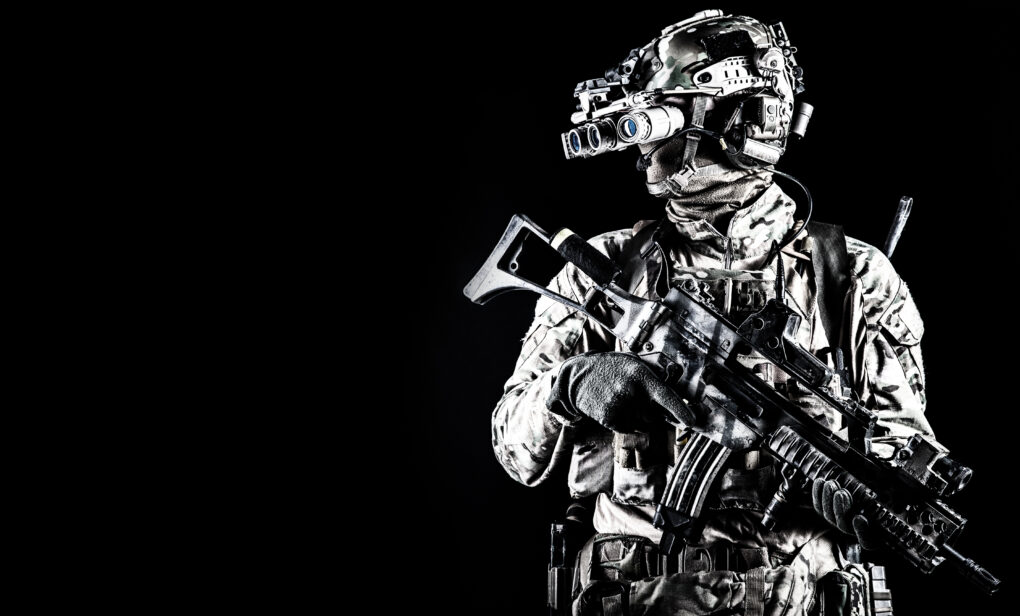ANVIS-10 vs GPNVG-18: which night vision goggle is best? We will break down the key differences and history of these panoramic night vision goggles.
Overview of ANVIS-10 and GPNVG-18
Despite being out of production for several years, the ANVIS-10 continues to be highly regarded for its relatively low price as far as factory-built panoramic units go. The difficulty in acquiring spare parts, particularly the unique image intensifier tubes it requires, has kept its status within the night vision community for those who manage to source it. Originally built for USAF pilots, the ANVIS-10 saw ground combat with a certain special missions unit (SMU) in Iraq and Afghanistan. Despite not being designed for ground use, the ANVIS-10 performed well enough that JSOC knew it needed a purpose-built version, as the advantages of the panoramic design were very apparent.
Out of this need came the GPNVG, the world’s first panoramic night vision goggles designed for the guy on the ground. The GPNVG-18 stands as a testament to contemporary innovation, aimed at amplifying situational awareness with its quartet of cutting-edge 18mm MX-10160 unfilmed white phosphor autogated image intensifier tubes. This sophisticated system enhances both spatial perception and visual clarity over a wider field of view when observing night-time images. This feature makes it highly sought after for tactical endeavors.
Field of View Comparison
The scope of visibility, commonly known as the field of view (FOV), plays a pivotal role in night vision technology. Both the ANVIS-10 and GPNVG-18 boast a 97° FOV, which greatly eclipses the conventional 40° FOV found in standard designs. This vast expanse of visibility drastically improves situational awareness by reducing the necessity to pivot one’s head continuously when scanning their environment. Such panoramic night vision capabilities are essential during tactical missions as they offer an uninterrupted and all-encompassing visual grasp of one’s surroundings. The configuration with four tubes not only extends horizontal sight but elevates depth perception too, yielding a more engaging and finely detailed view.
Design and Build Quality
The importance of a night vision device’s durability cannot be overstated, particularly in demanding scenarios. In this respect, the GPNVG-18 stands out with its more durable design, as it’s constructed to withstand the wear and tear experienced during ground combat.
Conversely, the ANVIS-10 is designed with an emphasis on being lighter weight for aviation applications and thus opts for a less robust design over more heavy-duty features. This proves advantageous for aviators who require light helmets to reduce head strain during prolonged periods of flight.
The modularity of the GPNVG-18 is notable. It offers user-friendly maintenance through its easily detachable pods which facilitate swift replacements or adjustments as needed.
Performance in low-light conditions
In environments where light is scarce, the GPNVG-18 stands out due to its utilization of four unfilmed white phosphor autogated image intensifier tubes. These tubes enable a marked improvement in the detail and clarity of the image, thereby increasing situational awareness while diminishing visual fatigue during extended periods.
Since the release of the ANVIS-10, the performance of gen 3 image tubes has continuously improved spec-wise. While the ANVIS-10 provides commendable low-light performance, it falls slightly short when compared with the latest tubes utilized by the GPNVG-18.
Power Options and Battery Life
The longevity and power source of a night vision device is critical. With four CR123A batteries in the remote battery pack, the GPNVG-18 can function for up to 30 hours, ensuring continued operation for prolonged activities.
The ANVIS-10 is capable of utilizing several battery packs that are readily available ANVIS-compatible options, which can give the device a battery life similar to that of the GPNVG.
Mounting and Compatibility
The GPNVG-18 is designed with flexibility in mind, accommodating multiple helmet types. The unit is available in both dovetail and ball-detent (ANVIS) mounting interfaces. On the flip side, the ANVIS-10 is purely a ball-detent interface. While the mounting solution is purely user preference, with each interface having its pros and cons, the ability to choose with the GPNVG-18 is certainly a plus.
Cost and Value for Money
The expense associated with acquiring night vision goggles plays a pivotal role in the purchasing process. The GPNVG-18 is respected for its cutting-edge technology and proficiency, reflected in its steep price tag of approximately $40,000.
Conversely, the ANVIS-10 presents itself as a more economically viable choice at a cost range of $10,000 to $15,000. Though it may be an older design, and can only be found in used condition, its performance still offers commendable value for money spent.
Ultimately, choosing between these goggles involves weighing their benefits against their costs. Those who prioritize leading-edge technology and are prepared to allocate additional funds might find that investing in the GPNVG-18 pays off. Individuals seeking an effective yet financially sensible alternative will find that opting for the ANVIS-10 can be advantageous.
Spare Parts
Maintaining and prolonging the operational life of night vision goggles hinges on access to appropriate accessories and spare parts. The GPNVG-18 is fully supported by L3Harris in the event the goggles become damaged or worn.
In contrast, sourcing proprietary components and accessories for the discontinued ANVIS-10 will be difficult, if not impossible.
Final Thoughts: ANVIS-10 vs GPNVG-18
In summary, the ANVIS-10 and GPNVG-18 each excel in their respective areas of application. When minimizing weight is essential, the lightweight construction of the ANVIS-10 makes it highly suitable. The lower price also makes it more attainable financially for the masses. Nevertheless, its phased-out production status along with a limited availability of spare parts could pose issues for some operators.
Conversely, due to its state-of-the-art technology offering an expansive field of view and enhanced low-light performance capabilities, the GPNVG-18 emerges as a standout choice. Its modular framework coupled with various additional features affords adaptability across diverse tactical situations.
Deciding between the two models ultimately hinges on personal needs and financial limitations. While both provide outstanding operational effectiveness, choosing which model best aligns with your mission’s unique demands is crucial in making an informed selection.


